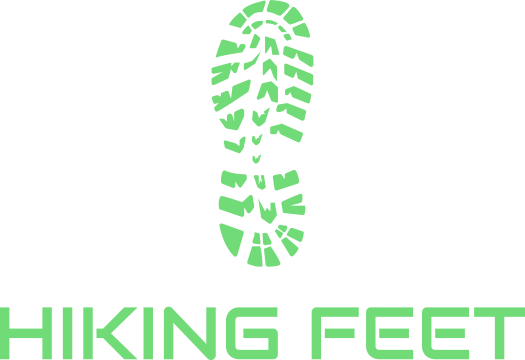The Anacapa Mid GTX is a day hiking boot that follows the HOKA blueprint— it's lightweight with maximum cushion. The boot's massive foam midsoles feature more than an inch of soft EVA foam for cushion and a rockered shape (raised toe/heel) to roll your foot forward into its next step. I've personally hiked around 400 miles in the HOKA Anacapa Mid and have reviewed all three of HOKA's hiking boots. So I have a strong sense of how the Anacapa compares with other lightweight hiking boots and with other HOKAs. You can learn more in my Hoka Anacapa Mid review.
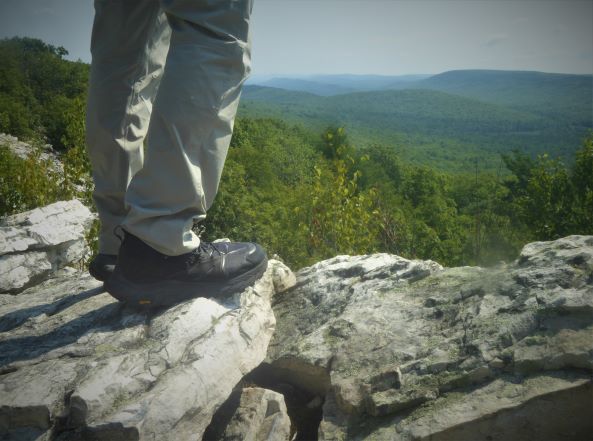
testing the Hoka Anacapa Mid GTX on Pennsylvania's Mid-State Trail
Meet the HOKA Anacapa Mid
In many ways, the Hoka Anacapa Mid GTX combines the best features of other Hoka hiking boots—and potentially addresses their limitations. That is, the mid-cut Anacapa
In 2023, Hoka updated the Anacapa with the Anacapa 2. The main difference between the original Anacapa and the Anacapa 2 is that the new version uses more recycled materials to reduce its environmental footprint. Hoka also added a non-waterproof Anacapa "Breeze" for hikers who want a more ventilated and faster drying hiking boot.
The Hoka Anacapa Mid is one of my picks for the best lightweight hiking boots. Its current MSRP is $195. Here are current prices:
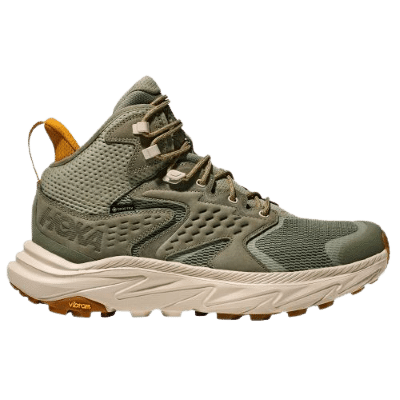
Men's HOKA Anacapa 2 Mid
Check current price, styles, and colors:
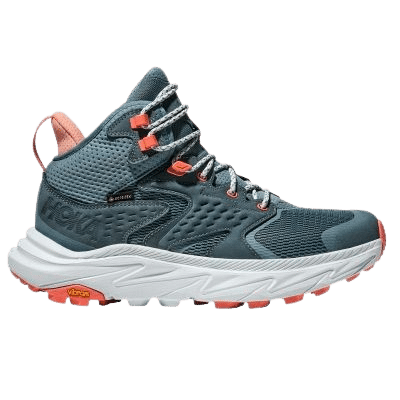
Women's HOKA Ancapa 2 Mid
Check current price, styles, and colors:
This post includes affiliate links, including the links above. If you buy something after clicking on one of these links, the retailer may share a small percentage of the sale with Hiking Feet. That's free for you and lets you support this site's free and independent content.
Hoka Anacapa Mid GTX Review
My Hoka Anacapa review is based on approximately 400 miles of first-hand hiking experience and 5 years of professional experience in the outdoor gear industry. Most miles have been in Pennsylvania—a state with small mountains and rocky trails that take their toll on hiking boots. For my initial review, I hand-picked trails that would test the Anacapa's support, weather protection, traction, and so on. Ever since, I've alternated my Ancapas with the rest of my hiking arsenal to compare them against the best hiking boots for men and women— especially other lightweight hiking boots.
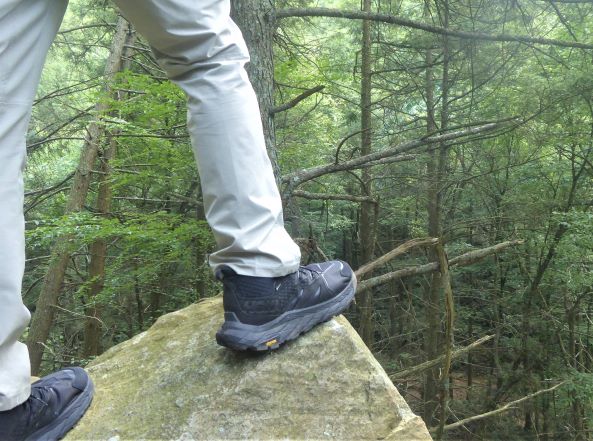
Support
Hokas don't have stiff TPU shanks or chassis underfoot like most hiking boots. However, their EVA foam midsoles are so thick that they prevent my feet from over-flexing on rocks and roots. Those soles also offer decent torsional rigidity— resistance to twisting—for some support against rolled ankles. In other words, the Anacapa Mid is not one of those overpriced sneakers marketed to hikers. It's a legit day hiking boot.
Even so, hikers shouldn't expect miracles from the Anacapa's soft ankle collars—they're not particularly tall or rigid. The mid-cut Anacapa boot offers slightly more ankle support than the low-cut Anacapa hiking shoe—but not much more. That being said, I haven't twisted my ankles in these boots over 400 miles.
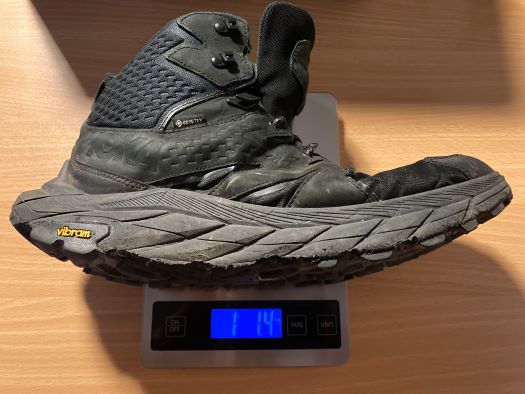
Weight
LIGHTWEIGHT
Most hikers don't buy Hokas for their support. They buy them for their cushioning and weight savings. And the Anacapa does stand out for its weight savings. The average men's pair weighs around two pounds and the average women's pair weighs a few ounces less. That's less than many low-cut hiking shoes and a lot less than the average hiking boot. For example, mine weigh about ten ounces less than my conventional, mid-duty hiking boots. Most "lightweight" hiking boots skimp on cushioning and support to cut weight—the Hoka Anacapa stands out as a lightweight hiking boot with max cushion.

Comfort
PLUS
Like all Hokas, the Anacapa sits on a thick pillow of EVA foam—heaps more cushioning than other lightweight hiking boots. At the same time, the Anacapa doesn't feel as soft and cushy as the Hoka Speedgoat trail running shoe. Hoka opted for a firmer midsole to give the Anacapa better durability and more of a hiking (not running) feel. You're still walking on mini-mattresses, but they're firm mattresses—not plush ones. [For a slightly softer ride, check out the new Hoka Trail Code GTX.]
Overall, comfort is a plus compared to other lightweight hiking boots—which usually cut cushioning to cut weight. Even so, I was a little disappointed that HOKA didn't totally crush it in the comfort category. My expectations may have been impossibly high here since Hoka's cushion game is so much better than other brands.
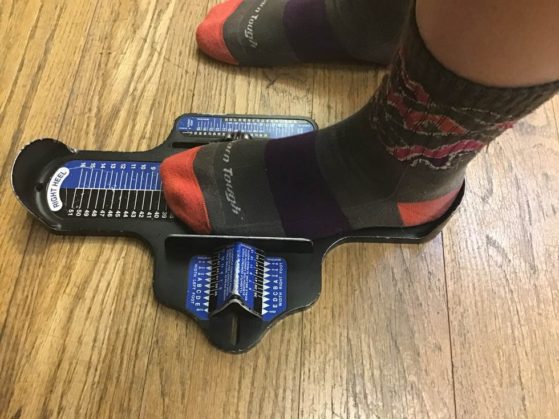
Fit
STANDARD
Hoka builds their footwear on three different lasts. The Anacapa is built on the brand's middle last, which means that its fit is standard to slightly large. My feet often require "wide" sizes, for example, but I can get by in the Anacapa (which is not available in a wide). Fit-wise, I also dig the boot's locking lacing system. The locking eyelets allow for different fits in the foot and ankle. In my case, I can lock in a looser fit in the midfoot (to accommodate my wide feet) with a tighter fit in the ankle (for better ankle support). (Hikers with narrow feet or thick calves/ankles could do the opposite.) That's a nice touch that allows for a more adjustable fit than most hiking boots.
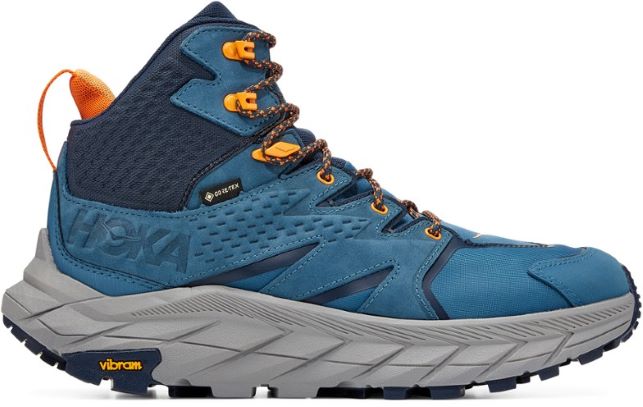
WEATHER PROTECTION
ABOVE AVERAGE
The "GTX" on the Anacapa GTX stands for GORE-TEX— still the most reputable waterproofing in the outdoor industry. GORE is both waterproof and breathable. So the Anacapa should be relatively good at keeping moisture out and releasing evaporated moisture through its GORE-TEX membrane. My pair has performed as expected in mud, puddles, and snow so far. Many of the trails I hike get sloppy in the valleys, and my feet have stayed comparably free of water and mud.
It also helps that this boot stands on top of those supersize midsoles. That extra inch of EVA foam gives a little extra clearance to keep some water, snow, and mud off the boot's uppers and away from its GTX membrane.
Traction
ABOVE AVERAGE
For me, this is one of the Anacapa's best features.
Anacapas feature Vibram Mega Grip outsoles. Mega Grip is a rubber compound known for good multi-surface traction on both dry and wet surfaces. My pair has excelled on some tricky tracks, including ankle-busting fields of rock talus, slickrock and lichen-covered boulders, and steep scree slopes that are especially slick on descents (when most falls occur). This particular outsole works well because it's soft enough to grip on solid rock but also features some aggressive, v-shaped climbing and braking lugs that can dig into loose and steep surfaces, too. In my experience, this tread is good (not great) in mud and better on rockier trails.
Value
FAIR
The HOKA Anacapa Mid now retails for $195. Compared to other lightweight hiking boots that I recommend, the Anacapa is $20 more than the Salomon X Ultra 4 Mid, $15 more than the Topo Trailventure 2, $10 more than the HOKA Trail Code, and $25 less than the Scarpa Rush 2 Mid GTX. Durability-wise, my Anacapas have been holding up well—better than my HOKA Trail Codes. That firmer foam seems to wear well and probably makes this lightweight Hoka hiking boot a little more durable than a Hoka trail running shoe.

Men's HOKA Anacapa 2 Mid
Check current price, styles, and colors:

Women's HOKA Ancapa 2 Mid
Check current price, styles, and colors:
Pros vs Cons: Hoka Anacapa Mid
My Hoka Anacapa review should help you decide if the Anacapa is a good choice for your feet, your budget, and your hikes. Overall, the boot's pros outweigh the cons:
Is the Anacapa Hoka's best hiking boot?
The best HOKA hiking boot varies by end use. For day hikers, the Hoka Anacapa 2 nudges the Hoka Kaha 3 (which I also like) because it's more than a half-pound lighter. The Kaha 3 is the best Hoka hiking boot for backpackers. The lightweight Hoka Trailcode GTX is another good pick for day hikers. The Anacapa edges the Trail Code in durabilty and support while the Trail Code has a slightly roomier fit than the Anacapa and a slightly softer and lighter feel. I prefer the fit and feel of the Trail Code, but my HOKA Anacapa Mids have demonstrated more durable cushioning over time.
For more in depth comparisons, please see my HOKA Kaha 2 Review and HOKA Trail Code Review.
Does the Hoka Anacapa Mid seem like your sort of hiking boot? Did my Hoka Anacapa review help you decide? If so, please consider picking up your pair through the affiliate links above. Hiking Feet may receive a small commission from the retailer (at no cost to you). Those commissions aren’t much. But they keep this site afloat. If this post hooked you up, please consider hooking me up, too. Thanks, I appreciate it!
